Are you good at writing? Maybe you are not. So if a computer system is available that helps you to improve your writing skills, are you interested in using it?
Writings encompass a large variety of works, including novels, essays, reportage, and commentary, each of which requires its own rules, techniques, and construction methods. In this column, writing skills refers to skills used to clarify your argument by presenting objective facts and keeping your writing free of ambiguity in its interpretation or redundancy. In other words, writing skills are skills that are required for properly writing reports, papers, manuals, and other technical documents.
The development of students’ writing skills, in addition to IT skills, is an essential issue for universities. The ability of students to comprehend and write reports, papers, and other technical documents is declining rapidly, and faculty staff who regularly meet students often complain about students’ lack of writing skills, particularly logical writing skills required for producing reports, etc. In fact, according to a survey by the Ministry of Education, Culture, Sports, Science and Technology in fiscal 2011*, more than 90% of universities provide a program for teaching writing methods, such as how to write reports and papers, as part of their liberal arts education.
Many of the universities that provide such a program prepare their own instruction methods and materials, with their faculty giving the lecture. However, to ensure improvement in students’ writing skills, lectures alone are not enough, but must be supplemented with practical exercises and training. However, providing precise writing correction and instruction in class will require the development of teaching methodology and the cultivation of many capable instructors. Unfortunately, for most institutions, this is not feasible and therefore cannot be implemented universally.
Taking into account this background, Aoyama Gakuin University started a project named “Promoting academic Writing education through e-Learning (PaWeL)” in 2008. Its objective is to utilize teaching-assistant tools based on natural language processing technology to help students develop their logical writing skills. The project is expected to ease the problem regarding the lack of instructors, and achieve effective training.
Natural language processing technology allows computers to understand Japanese, English, and other languages used by people in their everyday lives (natural language). The technology is used for various applications, such as Japanese conversion functions for word processing software, automatic translation, and the voice recognition function of smart phones.
Let us see how these tools can help to improve writing skills.
* Daigaku-niokeru Kyoiku-naiyo-to-no Kaikaku-jokyo-to-ni Tsuite [Current Status of University Educational Reform]. Fiscal 2011
The most important point regarding objective and logical writing is to construct your writing based on paragraphs. A paragraph is a group of sentences (or may only consist of a single sentence) that covers one topic. Changing paragraphs means changing topics; topics cannot be changed without changing the paragraph. To ensure that your writing is constructed effectively based on clear paragraphs, you need to observe the following three rules:
1.Each paragraph should maintain only one topic.
2.Each paragraph should start with a sentence that presents the subject of the paragraph concisely (topic sentence).
3.The first paragraph of the text should summarize the whole text.
Text constructed based on the above rules has many advantages, such as allowing readers to distinguish necessary from unnecessary information easily, avoiding overlooking important information, and tracing the author’s flow of thought with ease.
One of the PaWeL tools, called “Hinako,” is designed to help students learn this type of paragraph writing. Hinako is a learning support tool that visually and in an easy-to-understand manner shows the thinking process required to make a logical text structure.
The basic operation of Hinako is very simple. The screen displays two windows side-by-side. The left window shows text, while the right window shows topic sentences. You should be able to understand the content of the text simply by reading the topic sentences in the right window.
The operational procedure is roughly as follows:
(1) Open your text in the left window.
(2) Specify topic sentences to create a summary. (If no topic sentences are specified, the first sentence of each paragraph is automatically selected as the topic sentence.)
(3) Ensure that from the summary you are able to understand the content of the text. (See Figure 1.)
(4) Correct the text as necessary in the left window. (See Figure 2.)
(5) Repeat the above steps (3) and (4) until you are satisfied. (See Figure 3.)
Learners first load their text into the left window and click on the “Summary” button to display the summary of the text in the right window. If they are able to understand the content of the text simply by reading the summary, the text is considered to be sufficient, but if not, they need to correct the text in the left window. They also must check that sentences other than the topic sentence in each paragraph (supporting sentences) reinforce the main idea of the topic sentence. By repeating this training process, students can make it a habit to check their text to see whether the meaning of each paragraph and connections among the paragraphs are clear and whether the topic sentence of each paragraph clearly and concisely expresses the main idea of the paragraph, thereby improving their objective and logical writing skills.
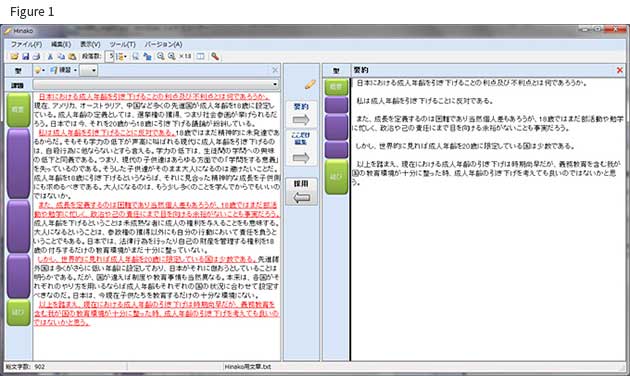
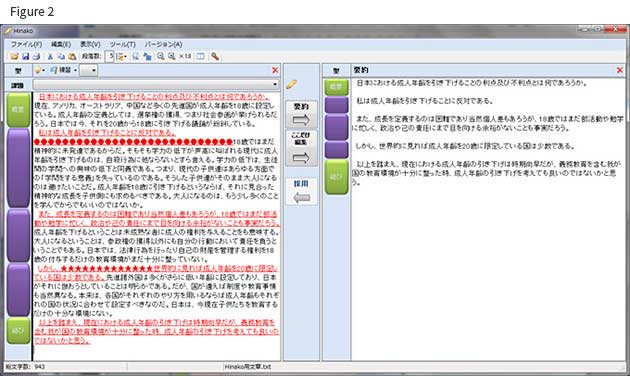
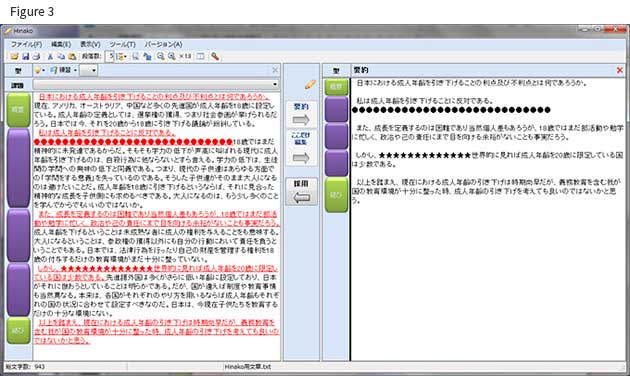
While Hinako is a paragraph writing tool for checking and providing training on ways to build text structure, Tomarigi, which I will explain next, is a proofreading and correction tool that helps students check expressions and wording sentence-by-sentence to correct any errors.
Students carelessly use expressions that are considered inappropriate for objective and logical writing, such as casual expressions (e.g. “yappari” rather than “yahari”) and coined expressions with no sufficient explanation (e.g. “. . . teki-na”). Surprisingly, these expressions are often found in their reports and papers.
Tomarigi is designed to find such errors in word usage and wording as well as inappropriate expressions such as colloquial expressions. The tool also analyzes text to check that the sentence-final form (dearu style or desu/masu style) is consistent, that the use of Chinese characters that are not common is avoided, that commas are put in appropriate places, that the same postpositional particle does not occur repeatedly, and that demonstratives are not used in excess, as well as other elements. The tool then identifies possible mistakes, provides detailed information on them, and proposes corrections.
Tomarigi’s basic screen (Figure 4) consists of four separate areas, each of which is given a particular function. The editor area framed in red is where students display, newly create, or correct their text. The error-indicating card area framed in yellow indicates types and locations of possible mistakes, sentence-by-sentence. The error detail card area framed in blue provides detailed information on possible mistakes indicated and, if necessary, proposes corrections. The text information area framed in green shows attribute information pertaining to the text, such as the number of possible mistakes indicated and the rate of occurrence of Chinese characters.
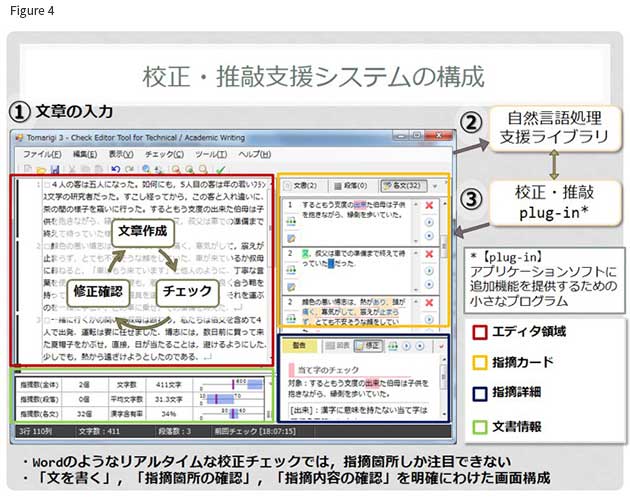
The basic operational procedure is as follows:
(1) Input text in the editor area.
(2) Execute proofreading of the text.
(3) Click on possible mistakes indicated in the error-indicating card area.
(4) Check the errors in the error detail card area and view the proposed corrections, if necessary.
(5) Correct the text in the editor area based on the proposed corrections.
Now, let us see an example of how Tomarigi indicates possible errors. Figure 5 shows a case in which the sentence “猫が追いつめたネズミが食べたチーズは腐っていた” (The cheese eaten by a mouse cornered by a cat was rotten) is input in the editor area. Tomarigi points out that it is difficult to figure out what is modified by what because the sentence has a nested structure with two modifier clauses ”猫が追いつめたネズミ” (a mouse cornered by a cat) and “ネズミが食べたチーズ” (cheese eaten by a mouse). Tomarigi, therefore, proposes that the single sentence be divided into two sentences: “猫が追いつめたネズミはチーズを食べた” (A mouse cornered by a cat ate cheese) and “そのチーズは腐っていた” (The cheese was rotten).
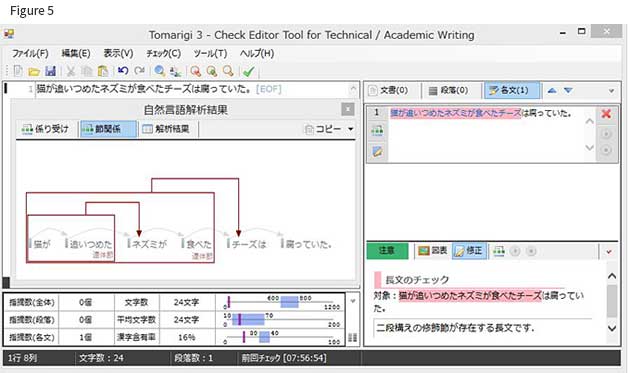
Figure 6 shows another example in which the sentence “役所の要望は窓口を、一本化して受付け内容は公表される” (All requests from governments are received centrally and disclosed) is input in the editor area. Tomarigi presumes how the phrases in the sentence are related to each other and indicates using symbols the locations where commas should be placed, where they can optionally be placed, and where they should not be placed. The tool also explains why a comma should not be placed between “窓口を” and “一本化して” and suggests that a comma should be placed after”受付け.”
In this way, Tomarigi helps students learn standard writing rules.
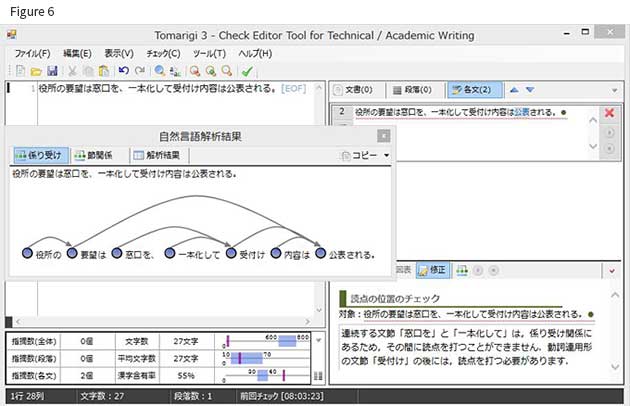
Aoyama Gakuin University provided students with an exercise course based on Hinako, Tomarigi, and other PaWeL tools in fiscal 2010, in which students were asked to write five types of text, each with a different purpose, using the tools: namely, an essay (500 characters), e-mail text for a request and an explanation (500 characters each), short paper (600 to 800 characters), and report (3,000 characters). On the last day of the course, we conducted a student questionnaire survey on the effectiveness of the tools. According to the survey, 74% of the students answered that they were able to write clearer text through the course and cited positive opinions such as “Thanks to Hinako, I was able to realize the role of topic sentences in paragraph writing,” and “Thanks to Tomarigi, I’ve begun to pay attention to errors in writing form, modification, and the types of mistakes that I tend to make.”
As mentioned earlier, Japanese writing skills that our tools help to improve are limited to those required for producing reports, papers, manuals, and other technical documents. However, if these kind of educational support tools become available for use by students to learn basic writing skills for themselves, the faculty may be able to concentrate on enhancing the quality of Japanese-language education. Furthermore, such tools may also prove effective in supporting foreign Japanese language learners. Learning Japanese poses a major obstacle not just for overseas students, but also for foreign people who wish to work in Japan as a nurse or caregiver. These tools may be useful for such people as well.
The technologies used for Hinako, Tomarigi, and other PaWeL tools introduced in this column are not necessarily leading-edge in the world of computer science, which includes my research fields in artificial intelligence and natural language processing. However, for researchers like us, it is an important mission to create something useful for society by coordinating existing research results and technologies, which does not require expensive equipment or software. We will continue our research and development activities to take these tools to the next level as educational resources.
Hinako, Tomarigi, and other PaWeL tools have been published as achievements from the PaWeL project and are still being continuously improved through joint research with Mr. Hiroyuki Ono, former research associate, Department of Integrated Information Technology, College of Science and Engineering, Aoyama Gakuin University and currently assistant professor, Division of Healthcare Informatics, Faculty of Healthcare, Tokyo Healthcare University. The tools can be downloaded from the PaWeL website (http://www.pawel.jp/).
Website for Promoting academic Writing education through an e-Learning (PaWeL)
(This column is as of 2015.)